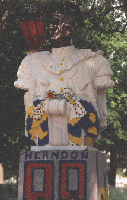






Named for the Shawnee Indian chief who helped the British capture Detroit during the War of 1812, the bust is actually that of Tamanend, the peacable leader of the Delaware inidians who befriended early settlers. Brought to the Yard in its original, wooden, form as the figurehead of the federal ship-of-the-line Delaware, the icon resided at several locations around the Yard, finally finding its way to the present spot in front of Bancroft Hall in 1917. By the late 1920s time and weather had beaten the original wooden relic severely, so the class of 1890 subscribed to have the present bronze casting produced. Cast at the Naval Gun Factory in Washington and incorporating the wooden "brains" and "heart" of the original figurehead, the bronze casting was installed on its marble base at the edge of Tecumseh Court in 1930. Tecumseh's normal color is the familiar dark brown patina of bronze, but every year for Commissiong Week, Parents' Weekend, Homecoming, and before the Army-Navy game the bust is painted in colors appropriate to the occasion.

Michelson Hall
 Map key 3 |
Michelson Hall is named for Dr. Albert Michelson (USNA 1873). In 1878, along a seawall near the site of the building bearing his name, Dr. Michelson became the first person to successfully measure the speed of light. In 1907, in recognition of his achievement, Dr. Michelson became the first American
to be awarded the Nobel prize in physics. A series of brass markers, embedded in the concrete plaza between Michelson and Chauvenet Halls, marks the line along which Dr. Michelson recorded his historic observations.
|


 Map key V | Commemorating the victory of Stephen Decatur over the H.M.S. Macedonian in the War of 1812, the monument is a replica of that ship's figurehead. The monument, which features four cannon captured from the Macedonian, is located at the end of Stribling Walk at Maryland Avenue. |



| Page 1 |  |
Page 3 |
 Annapolis National Cemetery
Annapolis National Cemetery
 Mike's railroad page
Mike's railroad page